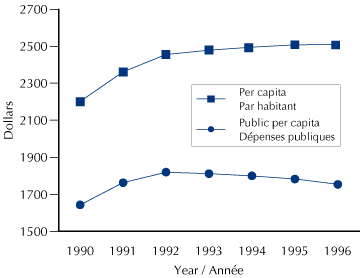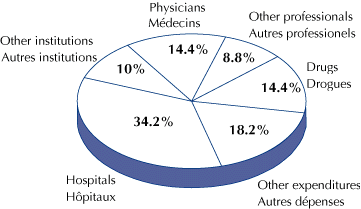Where is the money going?
CMAJ 1997;157:492© 1997 Canadian Medical Association
According to documents recently released by Health Canada, Canadians spent $75.2 billion on health in 1996, which equates to 9.5% of the gross domestic product (GDP). As a proportion of GDP, this puts us in fifth place internationally, behind the US, France, Austria and Germany.The physician component of health spending decreased slightly again in 1996, to 14.4% of the total, while the proportion spent on drugs continued to increase from its 1975 level of 10.2%. Proportionately, spending on drugs now matches payments to physicians. Hospital-sector spending has dropped steadily. It represented 44% of total health expenditures in 1975, but an estimated 34.2% in 1996.
Overall, per capita costs held steady at around $2500. Once adjusted for inflation, however, they showed a decrease for the fourth consecutive year. This is a direct result of a decrease in public-sector spending, for which unadjusted per capita costs have fallen since 1993. Inflation-adjusted (real) per capita drug expenditures have increased almost 50% in just over a decade, while the equivalent costs for physicians increased about 16%.
Public-sector expenditures now account for just less than 70% of total health costs, with private spending making up the difference. This continues the gradual decline in the amount of public spending, which stood at 76.4% of the total in 1975.
Per capita health expenditures in Canada
Dépenses consacrées à la santé par habitant au Canada

Distribution of national health expenditures by category, Canada, 1996
Répartition des dépenses nationales de la santé par catégorie au Canada, 1996
This column was written by Lynda Buske, chief, physician resources information planning, CMA. Readers may send potential research topics to Patrick Sullivan (sullip@cma.ca; 613 731-8610 or 800 663-7336, ext. 2126; fax 613 523-0937).
Send a letter to the editor responding to this article
Envoyez une lettre à la rédaction au sujet de cet article
| CMAJ August 15, 1997 (vol 157, no 4) / JAMC le 15 août 1997 (vol 157, no 4) |
| Other Pulse articles / Autres chroniques Médicogramme |
